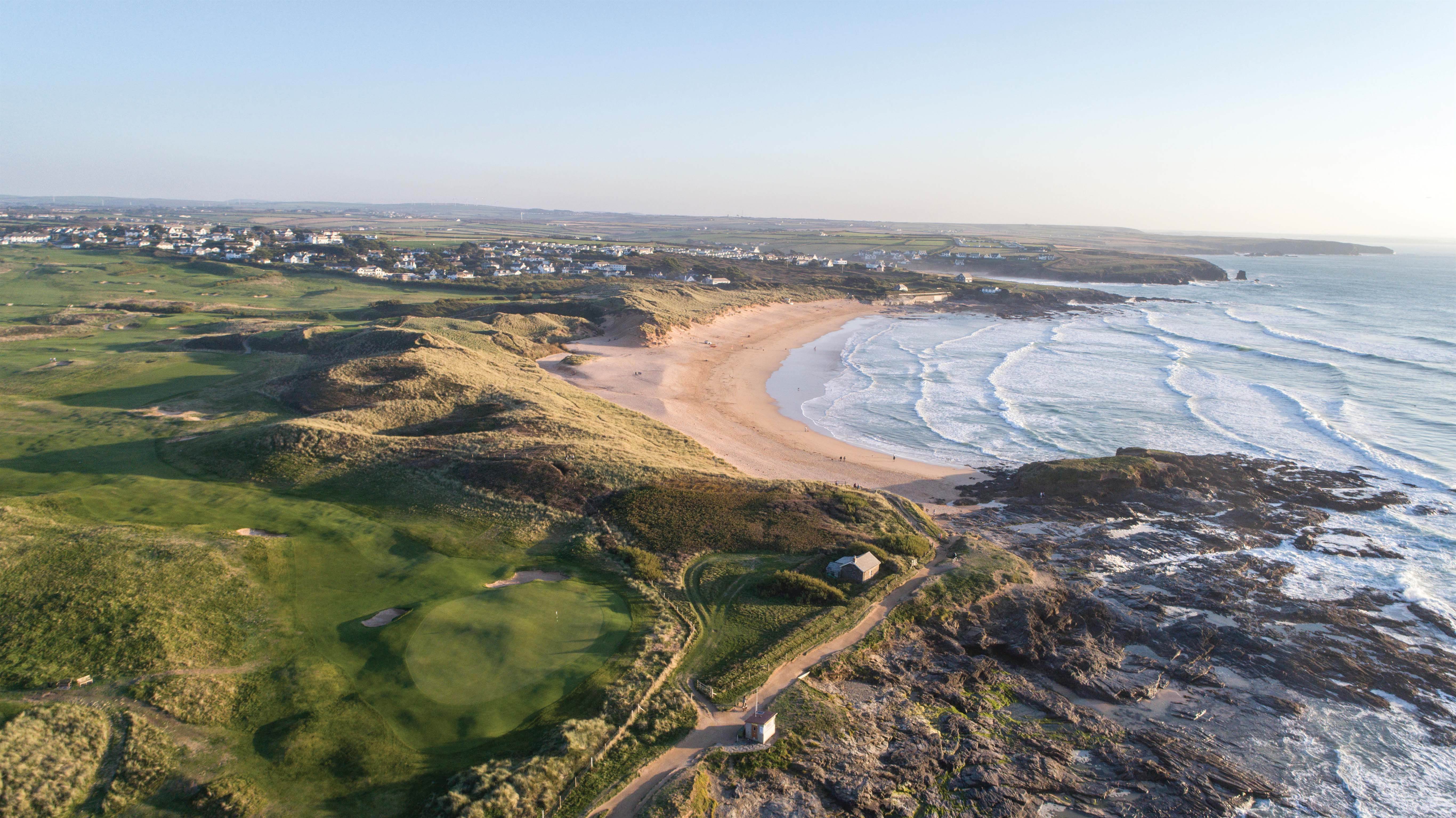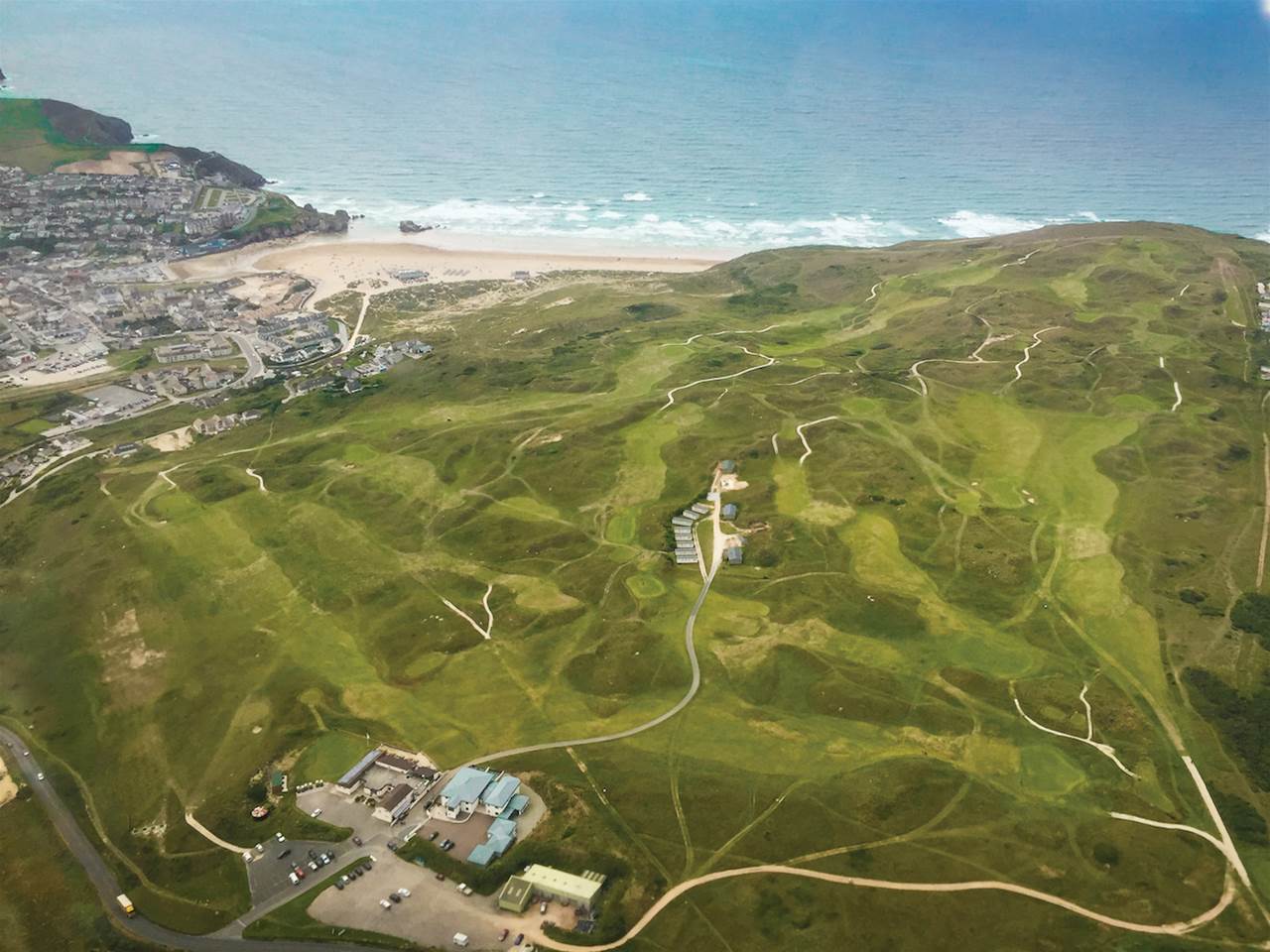Cornwall is renowned for its great food – everything from traditional Cornish pasties to incredible seafood – warm welcomes and incredible scenery from the wild moorlands and rugged cliffs to its sandy beaches. All of which makes this golfing journey as spectacular as the destination itself.
Fowler is indeed credited with formalising/redesigning the 18 we play today at Royal North Devon, the oldest course in all of England (1864) and located just south of Saunton across the River Taw. From one perspective this was perhaps the least inspiring stop on our itinerary. The ground here is very flat. The dunes that finally intercede on No.4 are gone by No.8 – indeed, the club has been obliged to reroute and reimagine holes 7 and 8 because the dunes have eroded so markedly (Mackenzie & Ebert have been tasked with this work, too).
“Where else might golfers share fairways with so many wandering sheep – and ponies?”
Much of the back nine zigs and zags quite blindly through massive stands of bull rushes with only signposts to guide new arrivals. In the wind, it can be most disorienting – and difficult. And yet … Westward Ho! is not to be missed. Where else might golfers share fairways with so many wandering sheep – and ponies? (Massive swaths of the Devon and Cornwall coasts are national heritage sites or otherwise held in trust, preserving ancient grazing rights. Environmental restrictions also mean Royal North Devon has not been altered much at all since Fowler was here, so this may be England’s best example of what 19th century golf was truly like. What’s more, the shore-access road runs right alongside the 1st and 2nd fairways; 3, 4 and 5 play parallel to the beach itself. This routing intermingles with golfers all manner of swimmers, surfers, kite-sailors, dog-walkers and sightseers. One rarely gets the feeling he is golfing alone at Royal North Devon – unless one is searching in vain for one’s ball amid the bull rushes).

Our foursome had stayed the previous two nights in a lovely Air B&B (Slade Cottage) south of the Taw estuary, and while the river town of Bideford and the more beachy hamlet of Westward Ho! were delightful (and full of restaurant options), our next home base lay an hour down the coast road, into Cornwall itself, where the pace is that much slower and the mobile phone coverage even more spotty. Padstow is the sort of chill, dreamy harbor town that urbanised Brits romanticise when they’re not on holiday in Cornwall. But it’s real enough and sits directly across the Camel River estuary from The Church Course at St. Enodoc Golf Club, a track that combines all the finest elements of West Country golf and rightly ranks among the most diverse, scenic links on Earth.
Stepper Point, the striking southern headland at the Camel’s mouth, is visible from the 1st green at St. Enodoc but doesn’t fully re-emerge until one is standing on 10 green. In between there isn’t a golf hole, a piece of terrain, a strategic scenario or scenic backdrop that even approaches the ordinary. The routing and most of the credit for all this go to architect James Braid, whose work here dates to 1907. His gaping Himalaya bunker at the par-4 6th is the most photographed/famous element in this early stretch but other highlights include the flamboyant fairway contours at the uphill 2nd and downhill 3rd, which drops 80 feet from the tee to rock-wall-guarded green; the extraordinary right-angled 4th, a short par-4 with out-of-bounds right and “long” (meaning 2 feet over the putting surface); the towering dune beyond Himalaya that accommodates the 6th green at its foot (and renders blind the tee shot on 7); and the mind-bending par-4 10th, which words cannot meaningfully describe. Suffice to say, it measures 457 mostly downhill yards but still manages to play substantially harder and longer than that.

By this time it feels as though one has walked a full round of golf but in fact the slack-jaw moments just keep coming. The church that gives this course its name, St. Enodoc’s of Trebetherick, is situated just right of the 10th green and dates to the 13th century. For a couple hundred years it sat nearly submerged in sand apparently; it was unearthed and restored in the mid-19th century, just prior to Braid’s arrival. Playing in such close proximity to such an ancient structure (including an awfully creepy graveyard) is fun. But the best view comes from the elevated 14th, back over the church to the estuary and Stepper Point. That would be a tough act to follow, but this is St. Enodoc: The 16-17-18 finish, playing high above the estuary over dramatic dunes terrain, is among the most epic and testing in Britain.
For our final two nights in the West Country we opted to stay just outside Padstow at Trevose Golf & Country Club, a full-on resort centered around a Harry Colt-designed course that has the misfortune of living in the shadow of its luminous neighbor to the northeast. But Mackenzie & Ebert renovated here, too, more comprehensively than anywhere else we played on this trip and the results are predictably grand. The terrain, always in sight of Trevose Head, is lovely; Colt’s routing is superb; and Mackenzie & Ebert’s bunkers are dramatic in the extreme – their rough edges seemingly “torn” away, to deploy the architects’ own parlance. What’s more, after the better part of a week “on our own” in various B&B settings, it was well to do some resort time with a lively bar and killer restaurant within walking distance of our condo.

Another welcome resort feature on our last day in Cornwall? Buggies. We took two and played Trevose at foursomes before heading down the coast where one last revelation beckoned. Perranporth Golf Club, where Sue McDevitt presides, is unlike anything we’d seen – not just in the West Country but anywhere frankly. Imagine if roller coaster rides required physical exertion. This may best describe the golf at Perranporth, another Braid creation that sits very high above the town and Perran Bay, atop an enormous headland covered with dunes. I’d never seen nor played a links set quite so high (read: utterly exposed to coastal wind) and designed quite so idiosyncratically. Every other hole features at least one blind shot – sometimes two. The ups and downs of the routing made the golf dramatic in the extreme, to say nothing of the walk. In a moderate wind (some 20-25 mph off the water), a few holes proved nearly unplayable but the entire experience was exhilarating.

Chatting over post round pints (a bit disheveled, in dire need of liquid sustenance), we fully understood why McDevitt made the move she did – and why golfers would do well to follow her example, if only for a week.
“The fact that I can stop off at the beach on my way home, get my toes into the sand, dip them into the cool Atlantic and sniff the clean sea-fresh air, somehow takes away any stress of the day,” she explained. “Don’t expect to get anything done in a hurry, don’t expect to get a consistent mobile or broadband signal and certainly don’t expect to earn a fortune. But do expect a totally joyful life.”

Related Articles

Review: Omaha Beach Golf Club

Drinks With... Ricky Ponting







_15th_hole.jpg&h=115&w=225&c=1&s=1)




